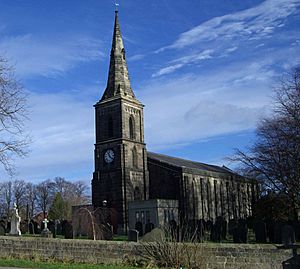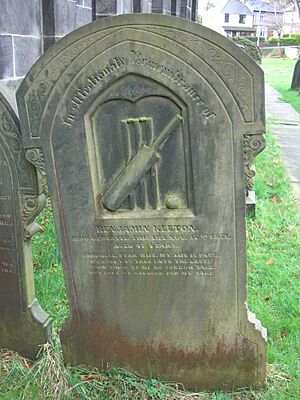Wadsley Parish Church facts for kids
Quick facts for kids Wadsley Parish Church |
|
|---|---|

Wadsley Parish Church
|
|
| OS grid reference | SK 32158 90694 |
| Denomination | Church of England |
| Churchmanship | Evangelical |
| Website | www.wadsleychurch.com |
| History | |
| Dedication | No dedication |
| Administration | |
| Parish | Sheffield |
| Diocese | Sheffield |
| Province | York |
Wadsley Parish Church is a special church located in Sheffield, South Yorkshire, England. It sits on Worrall Road, about 3 miles (5 km) northwest of the city center. The church is in a part of Sheffield called Wadsley, which used to be a separate village. What makes this church quite unique is that it isn't named after a saint, unlike many other churches. It's also recognized as a grade II listed building, meaning it's an important historical structure.
Contents
The Story of Wadsley Church
The idea for a church in Wadsley first came up in 1751. Two important people, William Burton and Margaret Bamforth, agreed that the main church in Ecclesfield was too far away. It was hard for people who were sick or couldn't travel easily to attend services. However, nothing happened with this plan for many years.
Building the Church
The church was finally built between 1832 and 1834. It cost about £3,500, which was a lot of money back then! A famous architect named Joseph Potter designed it. The church was built in the Gothic style, which means it has pointed arches and tall windows.
The money for building the church came from two wealthy sisters, Ann and Elizabeth Harrison. They were daughters of a successful saw manufacturer. The Harrison sisters had some very specific ideas for the church. They didn't like certain traditions of the Roman Catholic faith, especially parades with statues of saints. Because of this, they insisted on two things:
- The church should not have a central aisle. This would prevent any processions from taking place inside.
- The church must not be dedicated to a saint. This is why it's simply called Wadsley Parish Church.
How It Was Built
The sisters chose a spot called Fleester Field for the church. It was at the top of a gently sloping field. The building plans were changed a few times until the Harrison sisters were happy.
The building work started in the autumn of 1832. On October 22, 1832, the foundation stone was laid. About 600 children from local Sunday Schools watched the ceremony! William Wilson, the Harrison sisters' uncle, used a silver trowel to lay the stone.
The church officially opened on May 21, 1834. It was a little late because they decided to change the design of the spire. The first service was led by Reverend S. Langton, and Wadsley's first minister, Francis Owen, also spoke. The Archbishop of York, Edward Venables-Vernon-Harcourt, officially blessed the church on August 25, 1835.
Over the years, Wadsley Parish Church gained more independence. In 1841, it got its own district, separate from Ecclesfield. By 1857, the minister could perform all church duties, like announcing weddings. Finally, in March 1883, the church became completely independent.
The Fire of 1884
On Easter day in 1884, the church was badly damaged by a fire. The roof was destroyed, and much of the inside, including the pews and organ, was ruined. It took nine months and £1,700 to repair everything. A stone was placed above the porch door to remember this restoration.
Investigators found that sparks from a chimney caused the fire. The church couldn't hold services again until Christmas Day 1884. It was officially reopened by William Thomson, Archbishop of York, on February 12, 1885.
Later, in 1897, a choir vestry was added to the church. This was built to celebrate Queen Victoria's Diamond Jubilee. One of the most important people connected to the church was James Willis Dixon. He was the son of the founder of Dixon's silversmiths in Sheffield. There's a special memorial to him and his wife inside the church.
In 1917, George Cherry Weaver became the minister. He served for 30 years and saw many changes. Electric lights were installed, people no longer had to pay to sit in pews, and the churchyard was made bigger.
Wadsley Church Today
The church had a big makeover between 2002 and 2003. Some side balconies were removed, and the back balcony was made larger. New areas were added, including a quiet room, a kitchen, and a bigger welcome area. An office and new toilets were built outside the church, next to the spire. A special tank for baptism by immersion was also added, but the traditional font was kept.
The Graveyard
The church graveyard is the final resting place for many people. Some victims of the terrible Great Sheffield Flood of 1864 are buried here. This includes members of the Watson, Price, and Atkinson families. One grave for the Atkinson family mentions: "Ezra and Maurice, their son aged 15 and 9 months ... also William aged 13 and 4 months who perished by the bursting of the Bradfield reservoir, March 12, 1864". The Harrison sisters, who paid for the church, are also buried in the churchyard under a Gothic memorial.
Another interesting grave is known as the "Cricketer's Grave." This is where Benjamin Keeton, a well-known cricket player from the Hallam Cricket Club, was buried in 1871. He was 47 when he died. Benjamin wanted his grave to show his love for cricket. His wife, Fanny, followed his wishes and had a gravestone carved with cricket stumps, a bat, and a ball.
This gravestone caused some arguments at the time. The vicar and some church members thought it wasn't suitable. At one point, the stone was even knocked down! But after a public meeting, most people wanted it to stay, so it was put back up.
There's a large empty area in the graveyard without any gravestones. This is where hundreds of patients from the nearby South Yorkshire Asylum (which later became Middlewood Hospital) were buried during the Victorian era. They didn't have memorials because it was often seen as a disgrace for a family member to be in an asylum. Many burials were done with only the minister and a grave digger present.
There is also a memorial for 23 servicemen. These soldiers died from their wounds while being treated at the Wharncliffe War Hospital. This hospital was actually the asylum, used as a military hospital between 1915 and 1920. Another notable grave belongs to Dr. T. Allan Taylor. He developed a special nickel alloy steel that was important for creating the jet engine in the 1930s.


